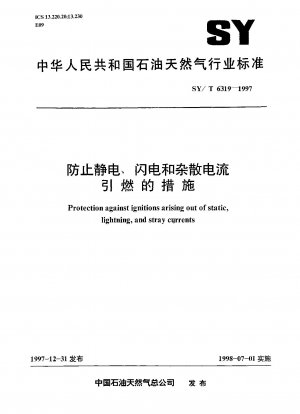SY/T 6319-1997
Protection against ignitions arising out of static,lightning,and stray currents (English Version)
- Standard No.
- SY/T 6319-1997
- Language
- Chinese, Available in English version
- Release Date
- 1997
- Published By
- Professional Standard - Petroleum
- Status
- 2008-12
- Replace By
- SY/T 6319-2008
- Latest
- SY/T 6319-2016
- Scope
- This standard describes current techniques for preventing hydrocarbon ignition in situations where static electricity, lightning, and stray currents are present. Recommended protective measures are based on research and practical experience in the petroleum industry. The principles discussed in this standard may also be applied to operations handling other flammable liquids and flammable gases. The application of this standard will improve safe operations and enable the evaluation of current installation methods and production processes. Furthermore, after correctly understanding the strict limits that can lead to static ignition, look for the real source of ignition when static ignition is unlikely or impossible. The following sections discuss some basic steps you should take to prevent static ignition. However, in the following situations, the recommended practices and precautions provided in this standard do not apply. a) Static discharge may occur, but the flammable vapor in the discharge area is isolated by deoiled air or inert gas. b) Store and transport products in closed systems where the oxygen content is below the minimum concentration required for combustion. For example, the storage and transportation of liquefied petroleum gas (LPG). c) The concentration of flammable vapor is higher than the upper combustion limit (UFL). d) Flammable vapor may occur, but there are no system conditions to produce static electricity accumulation and electrostatic discharge. This type of situation is more common in grounded transmission equipment that produces, stores and transports petroleum liquids such as crude oil, residual oil, asphalt (including diluted asphalt), heavy fuel oil (No. 6 heavy oil, etc.) and water-soluble liquids (such as ethanol). Due to their relatively high conductivity (greater than 50 pS/m), these liquids will not accumulate static charges and discharge. Experience has shown that these materials do not present significant electrostatic hazards unless they are broken into tiny droplets to form a charged oil mist. When this oil mist occurs, electrically insulated conductors may become subject to high electrical charges.
SY/T 6319-1997 history
- 2016 SY/T 6319-2016 Protection against ignitions arising out of static, lightning and stray currents
- 2008 SY/T 6319-2008 Protection against ignitions arising out of static,lightning and stray currents
- 1997 SY/T 6319-1997 Protection against ignitions arising out of static,lightning,and stray currents
